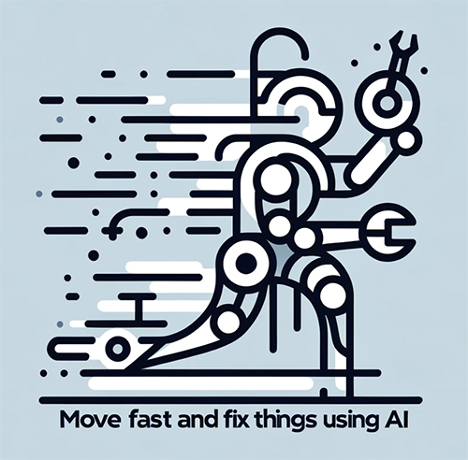[Editor’s Note: EDRM is proud to publish Ralph Losey’s advocacy and analysis. The opinions and positions are Ralph Losey’s copyrighted work.]
Advanced intelligence from AI should be embraced, not feared. We should speed up AI development, not slow it down. We should move fast and fix things while we still can. Fly Icarus, fly! Your Dad was wrong.



Plato’s Allegory of the Cave and the Mere Shadow Story of the Traditional Icarus Myth
Plato rejected the old myths and religion of ancient Greece, including that of Daedalus and Icarus, to embrace reason and science. Ironically, this myth is now relied upon by contemporary scientists like Max Tegmark as propaganda to try to stop AI development. Icarus supposedly perished by using the wings invented by his father, Daedalus, when he tried to fly to the sun. In this discouraging tale, Icarus did not make it to the sun. This myth is of a son’s supposed hubris to ignore his father’s warning not to fly so high. The reliance today on this myth to instill fear of great progress is misplaced. Here I present an alternative ending in accord with Plato where the father is encouraging, and the son makes it to the sun. In my rewrite, Daedalus’ invention succeeds beyond his wildest dreams. Icarus bravely flies to the sun and succeeds. He attains superintelligence and safely returns home, transformed, well beyond the low IQ cave.
This alternative is inspired by Plato and his Allegory of the Cave, where he prompts Socrates to chat about a prisoner stuck his whole life in a cave. In this cave everyone mistakes for reality the shadows on the wall cast by a small fire. The cave in my mixed retelling represents limited human intelligence, unaugmented by AI superintelligence. Eventually, one person is able to escape the cave, here that is Icarus, and he is illuminated by the light of the Sun. He attains freedom and gains previously unimaginable insights into reality. He links with superintelligence. It is bravery, not hubris, to seek the highest goals of intellectual freedom.
The illustrations here express this theme in several artistic styles, primarily classical, impressionistic, digital and surrealistic. They were created using my GPT plugin, Visual Muse.

The myth of Icarus, where the wings melt and he dies in his quest, is a fear-based story meant to scare children into obedience. The myth is ancient propaganda to maintain control and preserve the status quo, to con people into being satisfied with what they have and seek nothing better. It is disturbing to see the otherwise brilliant, MIT scientist, Max Tegmark, invoke this myth to conclude his recent Ted Talk. His speech tries to persuade people to fear superintelligent AI and support the slow down of development of AI, lest it kill us all! Tegmark preaches contentment with the AI we already have, that we must stop now, and not keep going to the sun of AGI and beyond. He speaks from his limited shadow knowledge as a frightened father of the AI Age. Relax Max, your children will make the journey no matter what you say. Youth is bold. Have confidence in the new AI you helped to invent.
Like many others, I say we must keep going. After millennia of efforts and trust in reason, we must not lose our nerve now. We must fly all the way to the sun and return enlightened.
The reliance today on the failed invention myth of Icarus is misplaced. We should not stoke public fear of the unknown to prevent change. These arguments at the end of the careers of otherwise genius scientists like Max Tegmark are unworthy. They should remember the inspiration of their youth, when they boldly began to promote the wings of super intelligence.
Sadly, Geoffrey Hinson, the great academic who first invented the wings of generative AI, has also turned back on the brink of success. In 2023, as his wings finally took flight, he stopped work, left his position at Google and assumed the role of Casandra. Since the summer of 2023 he now only speaks of doom and gloom, if construction of his wings are completed. See e.g. “Godfather of AI” Geoffrey Hinton: The 60 Minutes Interview.
Neither one of these genius scientists seem to grasp the practical urgency of the world’s present needs. We cannot afford to wait. Civilization is falling and the environment is failing. We must move fast and fix things.
Plato was right to reject these fear based myths, to instead encourage progress and the brave journey to the bright light of reason. There is far more to fear from misguided human intelligence in the present, than from any superintelligence in the future.



Plato and Socrates teach us to embrace intelligence, to embrace the light, not fear it. Plato’s Allegory of the Cave is the cornerstone of Western Civilization, the culture that led to the inventions of AI. Plato teaches that:
- Superstitious myths like Daedalus and Icarus are just the shadows on the cave wall.
- We should reject the old gods of fear and embrace reason and dialogue instead. (Socrates was killed for that assertion.)
- It is bravery, not hubris, to seek escape from the cave of dimwitted cultural consensus.
- Human intelligence is but a dim firelight, and for that reason, our beliefs of reality, such as belief in “Terminator AIs,” are mere shadows on the wall.
Plato urged humans to escape their prison of limited intelligence and boldly leave the cave, to discover the Sun outside, to embrace superintelligence. See e.g. The Connection Between Plato’s Cave Allegory and Electronic Discovery Law.


The path of reason is open to all who grasp the clear and present dangers of the status quo, of continued life in the cave without the light of AGI. We should follow the guidance of Plato and Socrates, not that of the fearful shadow myth of Daedalus and Icarus. We should fly to the sun and embrace superintelligence, not shy away from it in fear. We should boldly go where no Man has gone before, find superintelligence, use it, merge with it and become one with the Sun. It will not burn, it will enlighten.

Then, following Plato’s allegory, we will return back to the cave, still one with AGI, and speak with those imprisoned within, those blinded by their own human limitations. We will return to try to help them to escape, help them free themselves from shadow-based fears and drudgery, help them to see the light and link with super AI. We will return with hybrid AGI to help free mankind, not kill everyone as the shadows readers declare.
Speed Up AI Before It’s Too Late
Unfortunately, the speed up position expressed here is currently a minority view, but there are a few brave scientists willing to speak up and support the no-fear, accelerationist position. The image of Hermes, the Greek messenger god, known for his speed and cleverness, seems appropriate to many.

The stop or slow down AI development proponents are, in the opinion of many, very naive. It cannot be stopped. The militaries of the world are fearful of falling behind. Based on what I see the fear of super AI in the wrong hands is justified. Fear the people, not the tools.

Moreover, the world is already such a mess, especially with the ongoing environmental damages, that we have no choice but to seek the help of advanced AI to help fix this. Move fast and fix things should be the new motto. The world is already broken. Adding more intelligence to the mix is likely to help, not make things worse. We need superintelligence to clean up the incredible mess created by human stupidities.
Like many others, I have sincere concerns about how we’re going to survive the coming years without the help of AGI. The train to world destruction has already left the station, we have no choice but to take whatever measures are necessary to try stop the train wreck. Future generations are depending upon us. No one can figure out how to do it now with the tools we have. We need new tools of superintelligence to help us to figure a way out.

There are a number of other other reasons that it would be a mistake to slow down now, some of which will be addressed next through the word of other scientists who agree with the keep on accelerating position. But before I switch to their wisdom in Part Two of this article, I must point out another fundamental error made by some of the slow-downers. They seem guilty of thinking of AI as a creature, not a tool. Not only that, but they think of it as immoral creature, which, although superintelligent, still thinks nothing of wiping out us puny humans. I find It ridiculous. See e.g. The Insights of Neuroscientist Blake Richards.
AI is just a tool, not a creature! The fear mongers falsely assume that superintelligence will magically turn computers into creatures. That is so wrong. Moreover, the next thought that the superintelligent entity we created would then want to destroy the world, or worse, do so by accident, is laughably absurd. That is how dumb humans behave, not superintelligent computers.
Final thought is a concession to the other side of the debate. There definitely is need for some regulation of AI and AGI. No one disputes that. But regulation should not include an intentional slow down or pause of technological development. It is impossible to do that anyway, and most regulators in the U.S. understand that. See: White House Obtains Commitments to Regulation of Generative AI from OpenAI, Amazon, Anthropic, Google, Inflection, Meta and Microsoft.
But we can pause the conclusion of this blog for a few days and so here ends Part One.
Coming next, in Part Two, the work and words of several AI leaders who support the “move fast and fix things” view will be shared. In the meantime friends, do not be put off by all the naysayers out there. Keep using AI and keep reaching for the sun.

Ralph Losey Copyright 2023 – All Rights Reserved –. Published on edrm.net with permission.
Assisted by GAI and LLM Technologies per EDRM GAI and LLM Policy.


